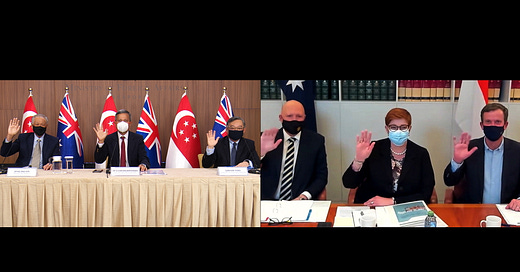Internationalising coercion concerns
Per the joint statement from the inaugural Australia-France 2+2 Ministerial Consultations on 30 August:
“Ministers committed to promoting economic openness and opposing coercive economic practices, which undermine rules-based international trade.”
Quick take:
This is the latest addition to a growing list (more details below) of joint statements and multilateral communiques that have addressed economic coercion and the global rules-based trading system. Although China is typically not mentioned by name, the context of the messaging leaves little room for doubt as to the guilty party. China’s internationally notorious and explicitly coercive economic pressure campaign against Australia means that most audiences would fully understand that Beijing’s trade restrictions are at issue.
France has longs been opposed—in both word and deed—to the US trade embargo against Cuba. With Australia having voted in the United Nations General Assembly in favour of a resolution urging the United States to end its economic blockade, it’s tempting to speculate that this joint statement might also have a subtle message for Washington. But given that joint statements and multilateral communiques addressing economic coercion have only become regular features of Australia’s diplomacy since circa late 2020, it’d be a massive leap to interpret this joint statement as a criticism of the United States’ decades-old Cuba embargo.
The lengthening list
With the addition of France to the list of countries expressing coordinated concerns about economic coercion, here’s my rough working record of who’s so far raised their voice in this way (apologies in advance for the dodginess of this graphic):
Quick take:
These are some of the recent public cases of bilateral and multilateral statements addressing (at least implicitly) China’s economic coercion against Australia. This record paints a picture of an increasingly active Australian effort to internationalise and multilateralise its concerns about China’s economic coercion. As Trade Minister Dan Tehan put the rationale for this strategy: “[W]e very much need to take a collective approach in calling [economic coercion] out – make sure that there is reputational issues at stake when countries use economic coercion.” I assume there are other bilateral and multilateral statements addressing China’s economic coercion against Australia that I’ve missed. (Although not explicitly connected to Australia, recent US-French statements might fit this bill.) Feel free to send through details of any that aren’t featured above. I’ll aim to expand the above and make it a working tally of such bilateral and multilateral statements.
This table excludes ambiguously framed references to coercion that don’t address economic coercion explicitly. Examples in that category include the August 2021 Quad Senior Officials Meeting’s reference to “coercive actions” and the regularly reiterated Australian and Japanese concerns about “coercive and unilateral actions”, which date back to at least the early 2010s. Although references to coercion broadly conceived presumably encompass economic coercion, specific references to economic coercion are a novel feature (so far as I can see) of the bilateral and multilateral messaging that emerges after the second half of 2020. Perhaps unsurprisingly, this shift to an explicit calling out of economic coercion correlates with the rapid expansion of China’s trade restrictions against Australia in late 2020.
The above table also excludes Australia’s independent interventions in bilateral and multilateral fora on the issue of economic coercion. Examples of this include the Prime Minister’s references to “economic coercion” in his July 2021 APEC Virtual Informal Leaders’ Meeting and his virtual address to the Australian American Leadership Dialogue in August 2021. These kinds of interventions are now a regular part of Australia’s diplomatic response to China’s economic coercion. But they are qualitatively distinct from bilateral and multilateral statements on the issue—not just because of how they are likely to be perceived in Beijing, but also because of the different weight they carry globally and what the bilateral and multilateral statements reveal about Australia’s ability to rally international support.
Plus ça change
“The most important current issue in the Asia-Pacific region is clearly the emergence of China as a dominant economic and military power. Recent regional expressions of concern about this development have centred not so much on China’s impressive economic and military capabilities, which have [long] been apparent … but on activities which appear to signal a change in its intentions. … [U]ncertainty about the terms of China’s inevitable transition to great power status and its willingness to seek regional accommodation … has led to profound questioning and healthy debate among politicians, academia and the public service as to how to read these signals and how best to manage the Australia-China relationship in the interests of both countries.”
Quick take:
Although published twenty-five years ago by the prolific scholar Ann Kent, this analysis could have been written in 2021. Some linguistic features might hint at its age (Asia-Pacific versus Indo-Pacific). But a central set of questions remains unchanged: The nature of Beijing’s intentions, the extent to which they are changing/remain unchanged, and the policy arenas in which they might be changing. As with the 1990s, the material measures of China’s power are today plain for all to see. But equally as with past decades, the debate over Beijing’s goals remains riven with deep analytical divides that have huge implications for many of the weightiest foreign and defence policy questions confronting Canberra today.
As always, thank you for reading and please excuse any errors (typographical or otherwise). Any and all objections, criticisms, and corrections very much appreciated.






